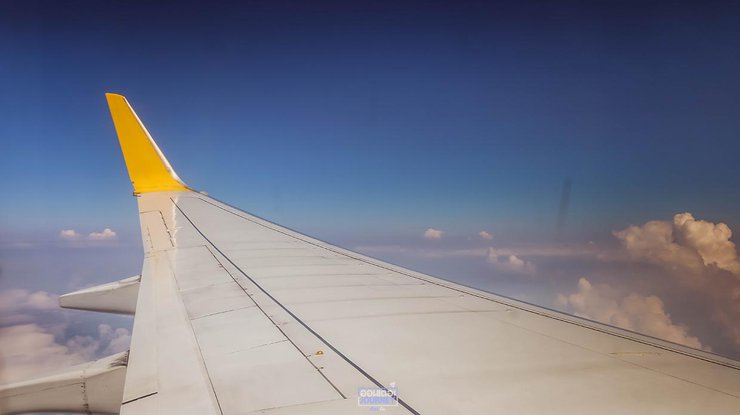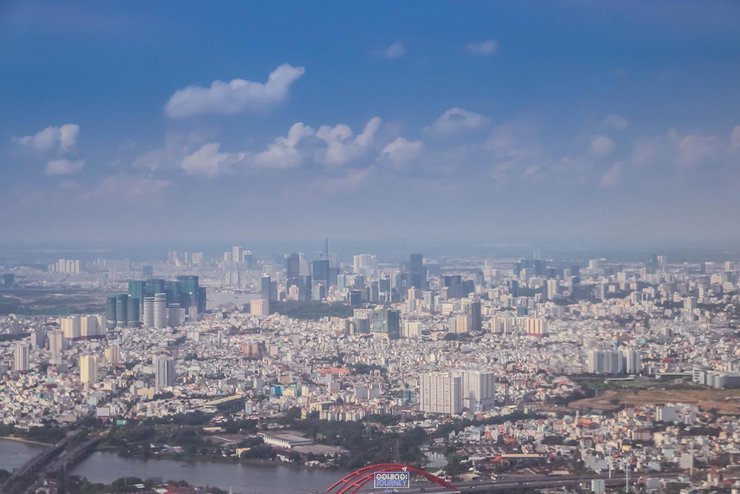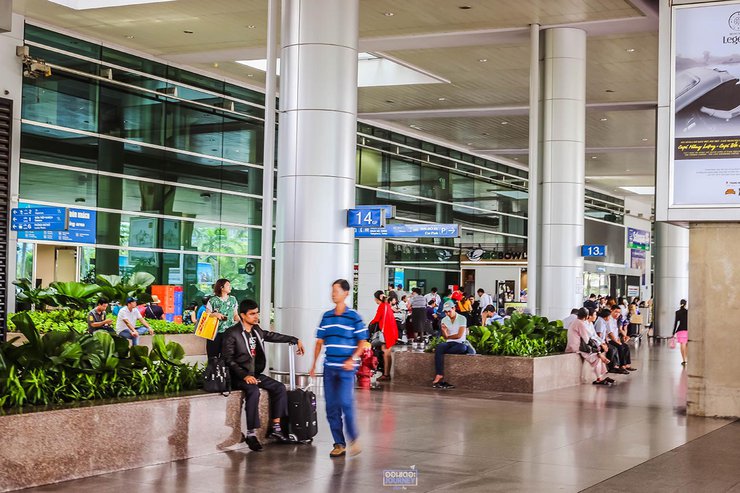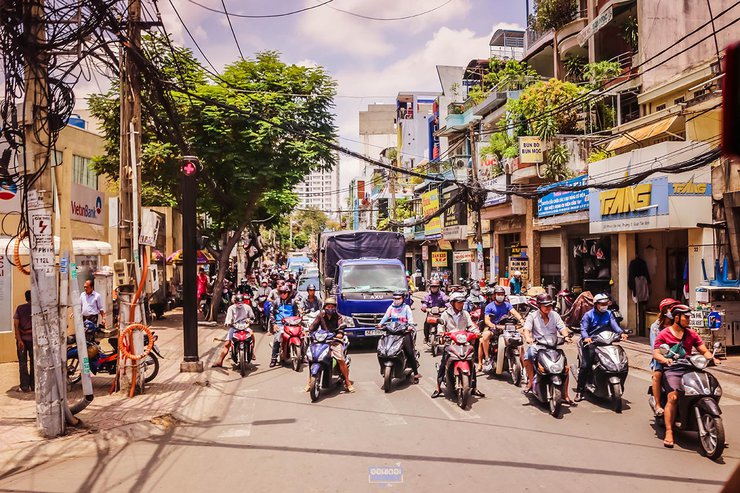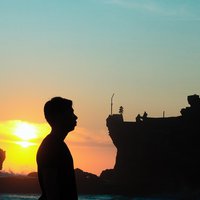If every starting point of a journey is filled with fear….
Fear of encountering past misfortunes, fear of the unexpected, fear of moving forward, and fear of encountering various dangers.
These fears may be obstacles that prevent us from venturing out to pursue potentially better opportunities.
Vietnam may be a country that many people think is dangerous and scary, but if we are afraid, we may miss out on experiencing the charm of this lovely little country.

Traveling to Vietnam has become much more convenient than before, with direct flights from Bangkok every day. Transportation options include both cars and airplanes.

The flight from Bangkok to Tan Son Nhat International Airport (try searching for the pronunciation on Google, it's quite challenging!) in Ho Chi Minh City, Vietnam, took approximately 1 hour and 30 minutes on Nok Air. The flight was delayed by about 20 minutes from the original schedule.

The demonstration of the equipment on the plane before taking off from Don Mueang Airport for the snacks on the plane should be exciting to use for a long time to open. Some passengers even use the method of slapping the bag to break it. It is also a difference in the Nok Air flight line. In total, it is strange. The amount of snacks is definitely not enough to eat. For those who fly in the morning flight, they should eat breakfast before boarding the plane.

Entering Ho Chi Minh City, the sky is clear today, offering a clear view. The scene before me shows that Vietnam has grown and developed significantly compared to 10 years ago when I last visited.

Hello Vietnam! We have arrived at Tan Son Nhat International Airport.
Accessing the city center offers a variety of options, including buses, taxis, and Grab bikes (Grab bike services are now available in Vietnam).

Although Vietnam has undergone significant changes over time, one aspect that remains constant is the widespread use of motorbikes. The sheer number of motorbikes is staggering, and they are ubiquitous throughout the city. Despite the abundance of motorbikes, crossing the street is surprisingly safe. Pedestrians can walk slowly and confidently, as the motorbikes will expertly navigate around them. Rushing across the street is not recommended, as it could lead to collisions.
Renting a car and driving in the city is not advised due to the chaotic traffic conditions. Additionally, motorbikes are permitted to drive on the sidewalks, which are significantly different from those in other countries. The sidewalks in Ho Chi Minh City have a unique curved design, allowing motorbikes to easily navigate congested areas.
One impressive aspect of Vietnamese traffic culture is the consistent use of helmets by both riders and passengers. This commitment to safety is commendable and contributes to the overall safety of the roads.


Vietnamese street food is a must-try for any visitor. From pho to French bread, there is a wide variety of delicious options to choose from. Locals typically have a two-hour lunch break from 11:30 am to 1:30 pm. However, they start work earlier and finish later than their counterparts in other countries.
The first tourist attraction that no one should miss when visiting Vietnam is the Notre Dame Cathedral.

Located in the heart of the city on Han Thuyen Street, the construction of the church began in 1877 and took six years to complete. Unlike other Christian churches, this one does not feature stained glass windows due to damage sustained during World War II. The Notre Dame Cathedral is widely regarded as one of the most beautiful churches in Vietnam, attracting numerous tourists daily. The church's architectural style reflects the colonial era, with its most striking feature being the twin square towers that rise 40 meters above the ground. A prominent white statue of the Virgin Mary stands in front of the church, serving as a popular tourist attraction. The statue symbolizes the arrival of Western influence and is a significant landmark in Ho Chi Minh City.
To visit the interior of the church, one must arrive during the morning Christian prayer service. The exact time is unknown, as it was closed during my visit.



While pre-wedding photography is abundant in this area, a unique and unfamiliar practice involves capturing the bride alone, without the groom. This distinctive approach showcases the bride's beauty and individuality.

This section also includes the Ho Chi Minh City Central Post Office, located in the heart of Ho Chi Minh City near the Notre Dame Cathedral. Constructed between 1896 and 1901, the post office boasts a French-inspired design and stunning stained glass windows. As the largest post office in Vietnam, it exudes grandeur and elegance, attracting numerous architects to study its design. The interior features antique nautical charts and portraits of former Vietnamese leader Ho Chi Minh. Services include mail delivery, collectible stamps, postcards, and international phone calls at standard rates.


The yellow building contrasts with the green sky, creating a unique and beautiful visual effect.

The interior retains its original character and still functions as a post office and international telephone exchange.


The gift shop located inside the Central Post Office offers a wide variety of souvenirs.

Folding paper into a postcard is another cute option. You can buy it and send it back to your country right away. There are many vendors selling them at various prices in front of the Central Post Office. Bargaining for a good price is another fun and exciting experience in Vietnam.

A way of life that has not faded with time, unfortunately, it will gradually fade away one day.
**Warning: The following image contains graphic and disturbing content.**
The brutal memories of the Vietnam War are like a nightmare that one desperately wants to erase, to wake up from and realize it was not real.
The War Remnants Museum showcases exhibits and photographs that chronicle the Vietnam War.


The exhibition area consists of three floors, showcasing photographic exhibitions with accompanying captions.

The goodness of a person is not determined by justice, but by the barrel of a gun.


No one could hold back tears. It was a scene too horrific to imagine, and everyone felt it, even through the images.


A replica of a prison used during the Vietnam War


The exhibition features over 250 photographs by Ishikawa Bunyo, a Japanese war photographer who documented the Vietnam War. These images capture the experiences of soldiers and civilians affected by the conflict, offering a poignant glimpse into the human cost of war.

Helicopters used in the Vietnam War

Shifting from the brutality of the Vietnam War, let's take a glimpse into the daily life of the people here during the evening hours.

Let's look into each other's eyes.
The auntie sells lottery tickets - The lottery here has both daily and local designs.


The streets of Ho Chi Minh City are not very wide, and the traffic moves at a slower pace compared to other cities. The maximum speed limit within the city is around 60-70 km/h. Ho Chi Minh City has a large number of mature trees, making it a shady and pleasant city with a cooler climate than Bangkok. Each tree within the city is clearly numbered. Most motorcyclists in the city wear face masks, which is a good way to protect themselves from pollution.


Strolling through the city's community areas is another source of shops selling various items.

Cruising the Saigon River is a must-do activity, with the iconic Tàu Bến Nghé boat, featuring a shark emblem. Bookings can be made in advance or on the spot, but be aware that tours can fill up quickly on busy days. The boat ride costs around 50-60 baht, and passengers can enjoy both the scenery and delicious food on board. The third-floor seating offers stunning views of the front of the boat. The river cruise takes approximately one hour, departing from the pier around 7 pm, sailing into the city, and then returning.

Modern Vietnam boasts dazzling skyscrapers illuminated by vibrant lights. The leftmost building, the tallest in Vietnam, is a recent addition to the skyline.



A new day in Ho Chi Minh City, we have a plan to travel to My Tho, Tien Giang province. This city is the mouth of the Mekong River, which flows from China through Myanmar, Laos, Thailand, Cambodia, and flows into the sea in Vietnam. This area is still fertile because it is a delta plain. There are many vegetables and fruits planted in this area. The journey to My Tho takes about 2 hours, with a distance of 70 km. It takes quite a long time because in Vietnam, the speed limit for driving is 60 km/h. There are many ways to travel to see the delta, including finding tours within Ho Chi Minh City, which are diverse and affordable. There are both 3-5 day tours or 1-day trips. The meeting point is set and then wait for the car to travel together in a large group. There are many foreign tourists and Asians, such as South Koreans.


Today's journey seemed to be going smoothly, but an accident in Ho Chi Minh City caused heavy traffic jams, even worse than those in Bangkok.

The capital of Tieng Giang province is My Tho city, which is also a tourist destination on the way to Can Tho. A suspension bridge has been built across the Mekong River, connecting southern Vietnam. This suspension bridge connects Tieng Giang province with Ben Tre province.



A suspension bridge connecting Tieng Giang and Ben Tre provinces.


The journey to the island in the middle of the water reveals a way of life that has been preserved. If we compare this island to our home, it would be like Koh Kret or Phra Pradaeng in Thailand. The Vietnamese people who live here are mainly engaged in fruit farming, beekeeping, and making coconut candy. The coconut candy here is very famous and there are many flavors to choose from, from pineapple to durian. As for me, the taste is quite strange, but one thing is for sure, it is very sticky to the teeth.


Production processes that still maintain their original identity

The local market offers a variety of souvenirs, so feel free to browse and purchase if you have extra cash.



Everyone praises the beauty of Vietnamese women. You can see how beautiful they are from this picture.



Shortly after leaving the island, it started to rain heavily. Although the rain was an obstacle to our trip, it also cooled down the weather significantly.
Initially, we thought the rain would last a long time, but after half an hour, it stopped. We continued our journey to Wat Win Ta Rang, which is not far from the pier. This temple is a unique blend of Vietnamese, Indian, Chinese, Khmer, Japanese, and Sino-Portuguese art. It is considered the largest and oldest temple in the province.







After enjoying the sights to our heart's content, it was time to return to Ho Chi Minh City. The journey back took about 2 hours, similar to the trip there. However, the entire 70-kilometer route was filled with motorbikes, creating a constant stream of traffic.

A country where motorcycles reign supreme.


For those who need to use the restroom along the way, there are gas stations available, but they are not comparable to PTT stations in Thailand. The restrooms are not excessively filthy, making them usable.

And the journey on the last day in Vietnam is coming to an end. A new morning has begun.

The Journey Begins at Thien Hau Pagoda: A Historical and Cultural Gem in Saigon's Chinatown
Our journey commences at the revered Thien Hau Pagoda, also known as "Ba Thien Hau Temple," nestled within the bustling heart of Saigon's Chinatown. This ancient temple, boasting a history spanning nearly three centuries, stands as a testament to the cultural tapestry of Vietnam. Erected as a tribute to the celestial patroness of seafarers, Thien Hau Pagoda mirrors the veneration of Mazu, the goddess of the sea, in Chinese tradition.
Beyond its significance as a spiritual haven for fishermen and maritime communities, Thien Hau Pagoda captivates with its intricate array of deities. The imposing statues of Mazu, Guan Yu, and other revered figures grace the temple grounds, while towering Chinese-style pagodas add to its architectural splendor.


This is considered another major highlight that no visitor to Vietnam should miss.

Long incense sticks are for people to worship. The ones you see floating are not hung up by themselves. There will be staff to hang them up properly.


The entrance to Thien Hau Pagoda has two access points: the main entrance and a side alley that runs through a row of shophouses. The pagoda is situated amidst these shophouses, a common sight in Ho Chi Minh City. Unlike detached houses found in other parts of Vietnam, the city is predominantly characterized by tall, narrow shophouses. Standalone buildings typically serve as government offices or historical landmarks.

Bánh mì, a popular Vietnamese breakfast dish, is a must-try for visitors to Saigon. The sandwich features a unique pâté filling made from ground pork liver, offering a distinct flavor experience. While the taste may not be for everyone, it's worth a try for those seeking an authentic culinary adventure.


Ho Chi Minh City is hosting a major marathon today, which can be considered a mega-project. The event is being broadcast live in front of the local television station, with a large crowd watching, many of whom have arrived on motorbikes. The LED screens used for the broadcast are comparable to those used by ITV in the UK.

In the heart of Vietnam's urban landscape, the Bitexco Financial Tower stands tall as the nation's current tallest building.
This location also houses SAIGON SKYDESK, an observation deck with a height of over 49 floors, offering a clear view of Vietnam. The BITEXCO FINANCIAL TOWER, on the other hand, boasts a height of over 68 floors and features a large helipad on its rooftop.





This is another landmark that is definitely worth a visit.

Walking from the building along the road, you will find a wide open space parallel to the road. From here, you can clearly see the statue of Uncle Ho, or Ho Chi Minh.

Ho Chi Minh Square, formerly known for its iconic statue of Uncle Ho holding a child, has undergone a transformation. The "Monument to Former President Ho Chi Minh" once stood proudly in the garden in front of the People's Council, serving as a symbol of Ho Chi Minh City and a popular gathering spot. In the evenings, the square's fountain area would come alive with Vietnamese and international visitors enjoying the scenery. However, the square has recently witnessed a change, with the statue now depicting Uncle Ho standing tall and majestic.

Vietnam has experienced significant development in recent times, with an atmosphere reminiscent of European countries.

The People's Committee Building, also known as Ho Chi Minh City Hall, is a French-style building with a central clock tower flanked by two prominent structures. Its arched doorways and windows, interspersed with Greek columns and delicate stuccowork, create a harmonious and aesthetically pleasing composition.

Before returning home, don't miss out on souvenirs! One of the best places to shop is Ben Thanh Market, the largest and most famous shopping destination in Ho Chi Minh City. Built in 1914, the market features a prominent clock tower as its symbol. Inside, you'll find a vast array of goods at negotiable prices.
From clothing and bags to shoes, food, tea, coffee, souvenirs, and even designer brands, Ben Thanh Market offers a diverse selection. Many Vietnamese vendors speak some Thai and are proficient in English. Bargaining is a fun part of the shopping experience here. If you show interest but don't agree with the initial price, the vendor will often present a calculator and ask, "What's your maximum price you want?" Feel free to negotiate until you reach a mutually agreeable price.







It's time to say goodbye to Vietnam. It's another unforgettable experience that I will cherish forever.
Is Vietnam dangerous?
Vietnam is another country where caution is advised when traveling and handling belongings. However, it is not so dangerous as to be considered an undesirable tourist destination.
Vietnam is a safe country in terms of traffic, and when crossing the road,
Vietnam is a country that still needs to be cautious, but the possibility of encountering thieves or robbers exists in every country. Nevertheless, it is always better to be safe than sorry.
Sure, here is the translation:
Sure, please follow the page at
Please.
journeyXreview
Tuesday, October 8, 2024 10:26 AM





